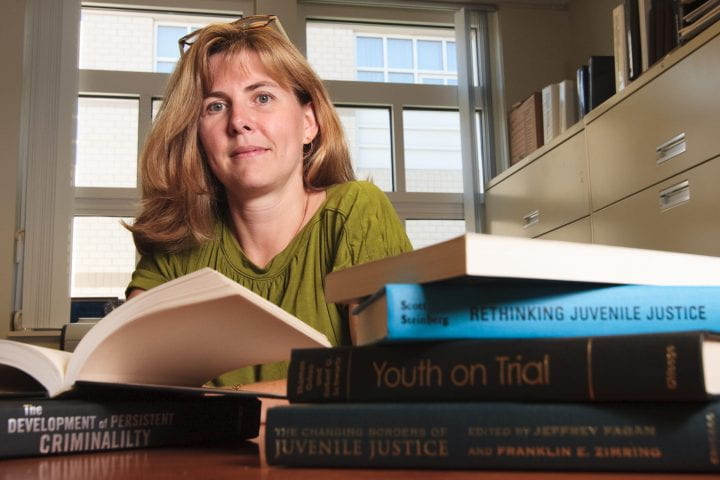Adjusting juvenile justice
New director of UCI’s Center for Psychology & Law wants social, legal policies to reflect limitations of adolescent brain development

Elizabeth Cauffman, UC Irvine professor of psychology & social behavior, is one of the country’s leading scholars on juvenile crime and justice. Her findings influenced the U.S. Supreme Court decision to abolish the juvenile death penalty, as well as the judgment that limits life-without-parole sentences for those under 18.
“We’re just starting to see courts relying on science and using it to justify their decisions,” Cauffman says. “It’s very encouraging to see that our research is affecting their decision-making process.”
She’s part of a team conducting a long-term, groundbreaking study on juvenile crime and prevention. The Pathways to Desistance project has tracked 1,300 serious felony offenders between the ages of 14 and 17 in Philadelphia, Phoenix and Orange County. Its goal is to learn what stops some juveniles from committing crimes and, conversely, why others maintain a life of crime. The results so far have surprised Cauffman and fellow researchers.
“We found that about 90 percent of these kids stopped offending by the time they turned 25,” she says. “A very small percentage continues committing crimes.”
The cease in criminal behavior was not due to any intervention or outreach programs, Cauffman says: “The best predictor of stopping youth crime is just growing up. It’s really just due to an increase in maturity and self-control. Older adults are also more resistant to peer pressure.”
She says it costs about $100,000 a year to incarcerate a child in a California juvenile detention center. For that amount, she notes, four kids could be educated in the University of California system.
“If I’m a businessman, that’s a terrible return on investment,” Cauffman says. “There’s a reason rental car companies don’t lease out cars to people under 25. They want to protect their investments.”
Risky behaviors such as binge drinking, drunk driving and unprotected sex tend to peak in adolescence. Cauffman blames this on the gap between cognitive development and emotional development. The brain’s frontal lobe – which regulates emotion and impulse control – isn’t fully mature until about 25.
One conclusion of the Pathways study was that longer stays in juvenile facilities did not reduce reoffending; institutional placement even increased the rate of repeated criminal behavior among those incarcerated for the most minor offenses.
“Youth who received community-based supervision and aftercare services were more likely to attend school, go to work and avoid further offending during the six months after release, and longer supervision periods increase these benefits,” Cauffman says.
She and fellow psychologists and criminologists in UC Irvine’s School of Social Ecology are consultants to the Orange County Probation Department and the district attorney’s office, offering research-based evidence to practitioners in areas ranging from the juvenile courts to the foster care system.
Helen Milojevich, a Ph.D. candidate in psychology & social behavior, assesses residents of the Orangewood Children’s Home, seriously abused and neglected kids from throughout the county. Their cognitive abilities and emotional, mental and behavioral health are evaluated, which lets Orangewood staff design treatment plans for them based on their needs.
“Everyone knows that abused children have challenges, but this assessment also helps us see where they’re doing well,” Milojevich says. “It’s important to address severe emotional problems but also foster and support resiliency and intellectual strengths.”
Highlighting the School of Social Ecology’s research and outreach is a goal of UC Irvine’s Center for Psychology & Law. Cauffman is the newly appointed director of the center and has organized public events on subjects ranging from rap music and the criminal justice system to wrongful convictions.
She says it’s the perfect venue for bringing important issues to a community audience.
“We try to pick both scholarly and relevant topics,” Cauffman says. “We often ask ourselves, ‘How can we take what we know and bring it to the field?’ As academics, we’re not good at translating our work, but we’re trying hard to get this information to the right people.”